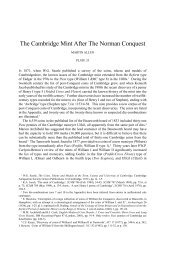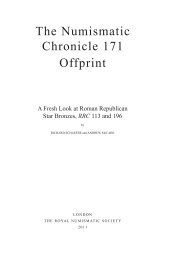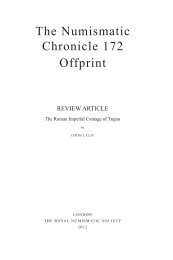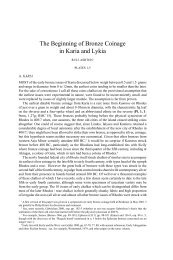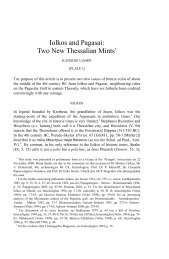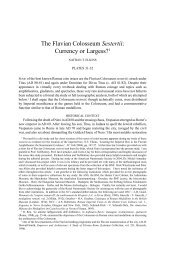The Numismatic Chronicle 171 Offprint - Royal Numismatic Society
The Numismatic Chronicle 171 Offprint - Royal Numismatic Society
The Numismatic Chronicle 171 Offprint - Royal Numismatic Society
Create successful ePaper yourself
Turn your PDF publications into a flip-book with our unique Google optimized e-Paper software.
THE CONFUCIAN MESSAGE ON VIETNAMESE COINS 401<br />
refl ection developed around the ethical concepts of ‘moral rectitude’ (đạo nghĩa 道<br />
義), ‘loyalty’ (trung 忠) and of ‘fi lial piety’ (hiếu 孝). Nguyễn Binh Khiêm 阮秉謙<br />
(1491–1585) was a striking example of a supporter of moral rectitude, a position<br />
which guided his political choices: he denounced the moral decadence of the Lê<br />
emperors, allied himself with the Mạc, then retired from political life. 238 But Neo-<br />
Confucianism gave pre-eminence to the Four Books over the Five Canons, and<br />
this inspired the Vietnamese authorities to create the status of ‘Doctor of the Five<br />
Canons’ in order to promote specifi c study of these texts, from the concern that they<br />
might otherwise be neglected. 239 <strong>The</strong> authorities reprinted the Five Canons and their<br />
commentaries to meet the needs of the schools in the capital and in the provinces;<br />
and they re-edited the versions in Vietnamese (nôm). <strong>The</strong> Book of Changes (Yijing)<br />
was studied as a Confucian text at the Imperial College, but was also used as a<br />
manual for divination by the Ministry of Rites. 240 At the end of the Lê dynasty, under<br />
the infl uence of the kaozheng 考正 movement, 241 the great Neo-Confucian scholar<br />
Lê Quý Đôn (1726–84) made a critical text of the Canons in his publications: Tales<br />
from the Shujing (Thư kinh diễn nghĩa 書經演義) and Superfi cial remarks on the<br />
Yijing (Dịch Kinh phu thuyết 易經膚說).<br />
Furthermore in 1802, the new Nguyễn dynasty found itself, to a certain extent,<br />
lacking legitimacy in its intellectual plan when compared with the scholars in the<br />
North, those of the previous kingdom of the Lê. <strong>The</strong> principality in the South, 242 from<br />
where the new rulers came, was not renowned in the area of canonical studies, indeed<br />
it was better known for its Buddhist leanings. <strong>The</strong> fi rst emperors thus had a policy<br />
to strip Thăng Long, the former capital, of its cultural and intellectual supremacy.<br />
Fearing that the candidates from the North would be too successful, not a single<br />
238 Nguyễn Binh Khiêm entered public service late, receiving the rank of doctor in 1535 at the age<br />
of 45. He joined the new power of Mạc Đăng Dung (Emperor Thái Tổ of the Mạc, 1527–9, then<br />
Thái Thượng Hoàng 太上皇, 1530–41) because of the behaviour of emperors of the Lê dynasty at the<br />
beginning of the sixteenth century, then withdrew when the new power refused to demote the corrupt<br />
offi cials for whom he had proof of embezzlement, see Poisson, Mandarins et subalternes, pp. 160–1.<br />
239 One cannot help drawing a parallel with what happened under the Han dynasty Emperor Xuandi<br />
in 51 BC, when the group known as Scholars of the Five Canons (Wujing boshi 五经博士) was set up.<br />
On the date of the creation of this group of scholars, generally attributed to Emperor Wudi, see Kern,<br />
‘Ritual, Text, and the formation of the Canon’, pp. 67–9.<br />
240 Ng WM, pp. 2–3.<br />
241 Kaozhengxue 考正學 (evidential scholarship) was an important Chinese intellectual movement,<br />
which became widespread in the eighteenth century, and which sought to re-examine historical and<br />
philosophical texts in the light of objective textual, philological and empirical criticism.<br />
242 During the seventeenth and eighteenth centuries, Vietnam was divided into two principalities.<br />
In the north, the real power was in the hands of the ‘king’ (vương) from the Trịnh clan, which left the<br />
emperor from the Lê family with only a fi ctive power of a religious nature; to a certain extent, the<br />
Vietnamese vương was to the Vietnamese emperor what the shōgun was to the Japanese Tennō. In the<br />
south, the lords of the Nguyễn clan transformed the government of Quảng Nam into an independent<br />
principality which they ruled hereditarily; within two centuries this reached progressively towards the<br />
south absorbing the Khmer territories. In 1774, profi ting from the Tây Sơn peasant uprising, the Trịnh<br />
brought to an end the principality of the South. <strong>The</strong> Tây Sơn then overturned the Trịnh, unifi ed the<br />
country and founded a new dynasty (1789–1802). In 1774, the Nguyễn princes fl ed to the extreme south<br />
and thence to Siam.



